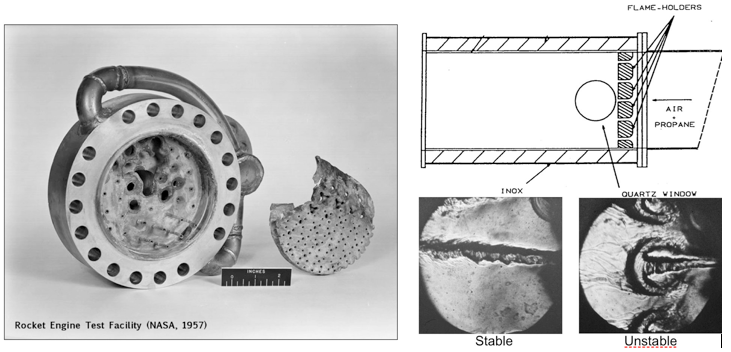CONTEXT AND MOTIVATION
The main motivation for computing and understanding CIs is that they represent a major risk for many systems based on combustion while combustion is the key in all future energy production processes. Almost ninety percent of energy on Earth is produced by burning fuel (Law, 2012). One issue that is never subject to controversy is the need to reduce our fuel consumption and to optimize the way we burn fuel. Even with a rapid growth of alternative sustainable energies, combustion will remain the first energy production process for a long time because the global demand for energy keeps increasing and is impossible to satisfy by just novel alternative sources. The fuels burned in combustors can be either non renewable fossil (oil for example) or renewable (hydrogen or biomass): thus, combustion can be a process to produce renewable energy. Combustion is also required to optimize sun or wind energy production. Indeed, only combustors can replace these systems efficiently on days without sun or wind: hybrid gas turbines are now being developed by Siemens or GE in order to combine solar (or wind) and natural gas at low cost and with limited climate impact. Combustion is an excellent vector to store or transport energy (by transporting hydrogen for example which can be produced by other means). Finally, certain systems (aircraft, helicopter, rockets) cannot operate at all without combustion. Therefore, the challenge for combustion science is to design systems that can burn fuels without wasting them, increasing pollution or modifying climate. To reach these goals, optimizing combustors and obtaining more power with less fuel, less CO2 emissions and less pollution is the first logical step. This optimization process relies more and more on simulation: instead of building combustors, they are created numerically and used to test optimized designs at low cost. Thanks to HPC, so called ‘virtual combustors’ have appeared in the last five years in some laboratories but at present, none of them can handle CI yet. The fantastic power of modern parallel computers suggests that HPC can now be used to develop these simulation tools and tackle CI problems. This integration of HPC into CI studies represents a significant but risky scientific challenge. However, it is a worthwhile path in terms of fundamental research and industrial applications for Europe.
CIs have been known and investigated for a long time. The image on the left of Fig. 1 shows a NASA rocket engine partially destroyed after the engine encountered CI while the right-hand side picture displays high-speed views of the flow in a laboratory burner for both stable and unstable regimes (the burner is built to resist CIs). The instability does change the flow drastically: it creates ‘mushroom’ shaped vortices and an accelerated flame that can destroy the chamber within a few minutes. In a real engine, this can occur within a few seconds. First identified by Lord Rayleigh in 1878 (see a simple video demonstration of combustion instabilities at elearning.cerfacs.fr/combustion/n7masterCourses/acoustic), CIs have been the hidden and feared problem of many combustion programs, starting with solid and liquid fuel rocket engines in the 50s and more recently gas turbines, industrial furnaces or even simple domestic heaters. In the field of NOx mitigation for example, multiple recent European projects (LOCOPOTEC or LOW NOX III) have lead to new combustor designs for gas turbines combustion chambers that were efficient in terms of NOx emissions but exhibited CIs that limited their practical use and required considerable additional developments as shown by the present EC projects where CI has become a central topic (KIAI, LEMCOTEC, TIMECOP).

Figure 1: an engine destroyed by combustion instability during the early years of the US rocket program (left) and a laboratory burner exhibiting both stable and unstable behaviours (right, PhD T. Poinsot).
From the fundamental point of view, CIs constitute one of the most challenging problems in fluid mechanics: they combine chemical kinetics, turbulence, acoustics and two-phase flow in complex geometries (typically real gas turbine engines). An additional difficulty to predict CIs is that the effect of uncertain parameters must be taken into account. Uncertainty Quantification (UQ) is a critical question in this field. Experimentalists have known for years that CIs are very sensitive to many parameters that are not well specified or even identified: small geometry changes (due to manufacturing tolerances but also to wear out effects during operation), air temperature, fuel composition, fuel spray characteristics or wall temperatures affect CIs. A minute geometry change in a gas turbine injection system can be sufficient for a combustor to bifurcate from a stable quiet regime to an unstable one destroying the combustor in a few minutes. This, obviously, is a crucial issue for many combustors. For solid rocket engines, out of ten (supposedly) identical engines, eight can be stable during tests and two unstable: identifying the source of this variation is a critical question. In the context of the introduction of alternative fuels (bio-fuels for example or mixtures of existing fuels with hydrogen as considered in the European initiative H2-IGCC, see www.h2-igcc.eu) in combustors, UQ becomes mandatory: is it possible that by changing slightly the fuel composition or by mixing two fuels, an initially stable combustor might suddenly become unstable?
The uncertainty problem also extends to the simulation tools themselves and creates new constraints. Predicting the stability map of a combustor (the domain where this combustor can be operated safely) is not sufficient any more: it is also necessary to determine the precision associated to this prediction. Uncertainty sources are linked to physical parameters (geometry, regimes, impedances) but also to modeling difficulties (mesh size, numerical scheme accuracy, sub models). Future simulation codes for CI must include tools to quantify precision associated to both physical and modeling parameters: this cannot be achieved without significant progress in both CI theory and computing technology. In conclusion, today, we do not have design tools allowing to predict CIs before final test phases: thus, CIs remain a major industrial threat and a fundamental scientific challenge that we propose to tackle in this project.
Research on CIs has been quite intense in the last hundred years and Europe has been very active in this field in various groups (Dowling 1997, Sattelmayer 2003, Noiray et al 2008). However, as noted by Culick in his classic 2006 monograph on CIs (and is still true today), High Performance Computing (HPC) applied to Computational Fluid Dynamics (CFD) has not entered the world of CI studies yet. This is somewhat surprising since combustion (with genetics and fundamental physics) simulations have been one of the first HPC applications over the last years: in ASCI projects funded by DOE for example (www.llnl.gov/str/Seager.html), CFD of reacting flows has always been an essential element. Three-dimensional unsteady reacting flows can be computed today with high-accuracy CFD codes using massively parallel computers available in the USA through programs like INCITE or in Europe through PRACE. The PRACE computers available today and the exascale computers that will be available (including in Europe) by year 2020 will revolutionize the field of numerical combustion: massively parallel codes have opened the door to the construction of ‘virtual burners’ that can entirely be simulated numerically instead of being built and operated experimentally. Interestingly, these HPC CFD codes have had a limited impact for the moment on CIs studies: most CI analysis tools (Crighton et al 1992, Lieuwen and Yang 2005, Poinsot et al 2005) still rely on approaches that do not exploit the power of modern computers. The integration of exascale computing (expected around 2020) in CI methods must begin now because it will bring unprecedented precision in this field and allow CI simulations to become truly predictive methods for practical applications. In particular, future exascale computing will allow using meshes in CI studies with 1000 to 10 000 times more grid points (which means increased precision) than today, thereby taking into account all geometrical details of combustors, which is currently not possible. Similarly, this unprecedented computing power will also allow including more detailed physics. For example one will be able to describe acoustics and two-phase flow (Riber et al 2009), which control the atomization of liquid fuels (kerosene, gasoline or biofuels) in combustors. Two-phase flow is one of the strong topics developed at IMFT (Pr Simonin, Dr Magnaudet).
During the last twenty years, we have developed several HPC CFD codes at CERFACS and CIs studies at IMFT. The moment seems to be opportune to introduce the recent progress in HPC technology into CI studies. The objectives of INTECOCIS are (1) to revolutionize the simulation tools used for CI studies by introducing recent progress achieved for flow simulation on massively parallel computers into this field; (2) to bring UQ methodologies to this field at the same time and (3) to validate and apply these methods to a few selected overarching problems in the CI community, including laboratory-scale experiments but also real industrial configurations in collaboration with European industry.
REFERENCES
N. Branley and W. P. Jones. Large eddy simulation of a turbulent non-premixed flame. Combust. Flame, 127:1914-1934, 2001.
D. G. Crighton, A. P. Dowling, J. E. Ffowcs-Williams, M. Heckl, and F. Leppington. « Modern methods in analytical acoustics. Lecture Notes ». Springer Verlag, New-York, 1992.
L. Crocco. Aspects of combustion instability in liquid propellant rocket motors. Part I. J. American Rocket Society, 21:163-178, 1951.
A. P. Dowling. Nonlinear self-excited oscillations of a ducted flame. J. Fluid Mech. 346, 271-290, 1997
F. E. C. Culick and P. Kuentzmann. « Unsteady Motions in Combustion Chambers for Propulsion Systems ». NATO Research and Technology Organization, 2006.
F. Duchaine, L. Selle, and T. Poinsot. Sensitivity analysis of transfer functions of laminar flames. Combust. Flame, 158 : 12 : 2384-2394, 2011.
C. Fureby. LES of a multi-burner annular gas turbine combustor. Flow, Turb. and Comb., 84:543-564, 2010.
R. Leandro, A. Huber, and W. Polifke. taxmanual. Technical report, TU Munchen, 2010.
C.K. Law. Fuel Options for Next-Generation Chemical Propulsion. AIAA J. 50, 1, 19-36, 2012.
T. Lieuwen and V. Yang. Combustion instabilities in gas turbine engines. operational experience, fundamental mechanisms and modeling. In AIAA Prog. in Astronautics and Aeronautics, 210, 2005.
F. Nicoud and T. Poinsot. Thermoacoustic instabilities: should the Rayleigh criterion be extended to include entropy changes ? Combust. Flame, 142:153-159, 2005.
N. Noiray, D. Durox, T. Schuller and S. Candel. A unified framework for nonlinear combustion instability analysis based on the flame describing function. J. Fluid Mech. 615, 139-167, 2008.
E. Riber, M. Garcia., V. Moureau, H. Pitsch, O. Simonin, and T. Poinsot. Evaluation of numerical strategies for LES of two-phase reacting flows. J. Comput. Phys., 228 : 539-564, 2009.
A. Roux, L. Y. M. Gicquel, Y. Sommerer, and T. J. Poinsot. Large eddy simulation of mean and oscillating flow in a side-dump ramjet combustor. Combust. Flame, 152 (1-2):154-176, 2007.
S. Roux, G. Lartigue, T. Poinsot, U. Meier, and C. Berat. Studies of mean and unsteady flow in a swirled combustor using experiments, acoustic analysis and large eddy simulations. Combust. Flame, 141:40-54, 2005.
T. Sattelmayer. Influence of the Combustor Aerodynamics on Combustion Instabilities From Equivalence Ratio Fluctuations. J. Eng. Gas Turbines Power 125, 1, 11, 2003.
P. Schmitt, T. Poinsot, B. Schuermans, and K. P. Geigle. Large-eddy simulation and experimental study of heat transfer, nitric oxide emissions and combustion instability in a swirled turbulent high-pressure burner. J. Fluid Mech., 570:17-46, 2007.
A. Sengissen, J. F. Van Kampen, R. Huls, G. Stoffels, J. B. W. Kok, and T. Poinsot. LES and experimental studies of cold and reacting flows in a swirled partially premixed burner with and without fuel modulation. Combust. Flame, 150:40-53, 2007.
G. Staffelbach, L.Y.M. Gicquel, G. Boudier, and T. Poinsot. Large eddy simulation of self-excited azimuthal modes in annular combustors. Proc. Combust. Inst., 32:2909-2916, 2009.
P. Wolf, G. Staffelbach, R. Balakrishnan, A. Roux, and T. Poinsot. Azimuthal instabilities in annular combustion chambers. In NASA Ames/Stanford Univ. Center for Turbulence Research, Proc. of the Summer Program, pages 259-269, 2010.


